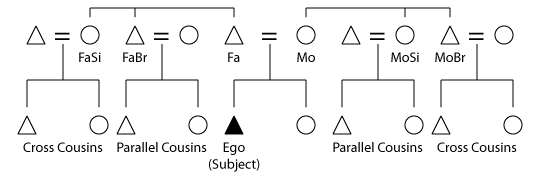Parallel and cross cousins
Parallel cousin is an anthropological term denoting consanguinial kin who are in the same descent group as the subject and are from the parent's same-sexed sibling. Simply put, a parallel cousin is a first cousin who is the child of the father's brother or the mother's sister.

Unlike cross cousins, parallel cousins are usually not the subject of promoted marriage since a union in many cultures would fall under an incest taboo. In a patrilineage, parallel cousins are part of the subject's (ego's) unilineage whereas cross cousins are not. The same is true in matrilineal societies, wherein parallel cousins are considered to be related to the subject (and therefore unwedable) while cross cousins are not.
Naming conventions
In many societies parallel cousins use names that we often associate only with direct siblings. For instance, in the Omaha system, a male parallel cousin is referred to as "brother". Likewise, a female parallel cousin is "sister." This system is also in place in the Crow system and the Hawaiian system. The Iroquois system is different in that they apply sibling naming terminology to cross cousins as well. This system is not in use in the Eskimo system, nor in the Sudanese system as they have seperate terminology for cross and parallel cousins.
See also
Sources and External links
